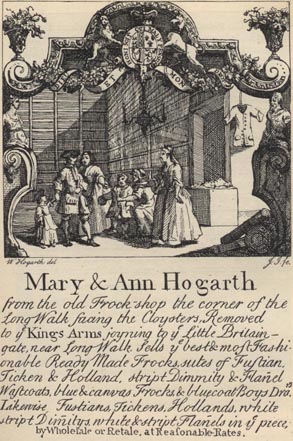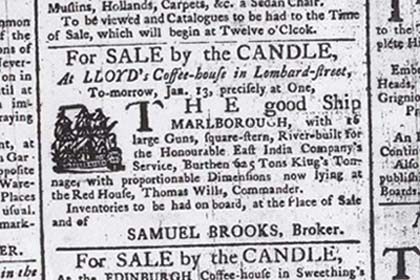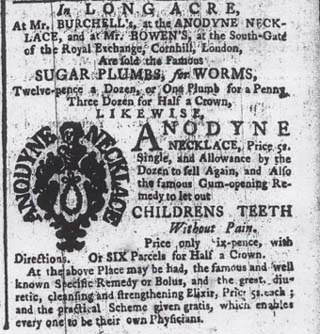
"I look upon them as
pieces of domestic intelligence, much more interesting than those paragraphs
which our daily historians generally give us, under the title of home news...the
advertisements are filled with matters of great importance, both to the great,
vulgar, and the small."
–Fog's Weekly Journal, 1736 (1)
The ECE Advertiser can't survive on sales alone. For
just two shillings you can help us survive while making money for yourself.
Just place an advertisement in our newspaper (2).
The thousands of readers who peruse our paper daily can make you rich. Our
newspaper, like others, is widely available at London coffee houses and taverns
(3).
We charge only two shillings per advertisement, and as an added bonus, many
coffeehouse owners will display your advertisement publicly, further increasing
the circulation (4).
Not to mention the fact that your support will help keep the cost of this
newspaper down for your fellow readers (5).
A little imagination and a spot on our front page is all it takes. You, too,
can join the masses of people moving up the social ladder.
|
Placing an 18th-century advertisement is easy. You just
need to know a little bit about the tactics and products of your advertising
colleagues in order to compete and, hopefully, beat them at their own
game. Here are some helpful hints to get you started.
The most important thing to remember is that there are no laws in advertising.
You're after results. Honesty may or may not be essential to your campaign.
No code of advertising ethics, legal or informal exists in the 18th
century (6).
First, you must decide what product you plan to advertise. Most advertisements
in the 18th-century related to medicine, the press, or commerce (7).
Imported or luxury goods, such as jewelry and furniture, rarely made
it to the pages of an early 18th-century newspaper (8).
Instead, newspapers and advertisers focused on products that appealed
to a mass market. They generally targeted themselves to the middle and
upper-middle classes (9).
By the mid-eighteenth century, the variety of ads began to increase.
Ladies' fashions as well as silver, brass, and copper items became subjects
of advertisements (10).
|

|
|
An example of an eighteenth-century shop bill
|
Although quack doctors make up a significant percentage of your
advertising colleagues, you can choose to be a legitimate advertiser. You
might choose to advertise for stolen property or to lobby for a political
project. Social and political groups sometimes advertise, as do organizations
looking to buy or sell land (11).
Advertisements for schools, wetnurses and lost property are also common in
country newspapers (12).
Keep in mind that your advertisement will probably not include
graphics. Although some newspaper advertisements did contain small graphics,
they were rare. If you wish to advertise graphically, you should make use
of handbills, tradesmen's cards, or shop signs.
Your readers, like you, want to take advantage of the growing
consumer society to climb the social ladder. If you want them to buy your
product, address them as you would address the aristocracy (13).
It is also critical that you treat your readers as intelligent, skeptical
consumers. The boom in advertising, especially medical advertising, in the
18th century has left many consumers skeptical. Establish the authenticity
of your product over other similar products. Many advertisers provide a certificate
of authenticity with the sale of their product and warn customers against
inferior lookalikes (14).
If your product isn't novel and fashionable, create a new fashion to meet
your desire for sales. The London market is highly changeable and suggestible.
The famous and profitable button manufacturer, Matthew Boulton, schemed to
introduce his buttons into the King's court by sending presents to nobles
and bribing servants of the royal family to push his product. When he revealed,
through advertisements, that the royal family wore exclusively Boulton buttons,
his buttons became the newest fashion (15).
Obviously, Boulton's technique was ideal, but you don't need to have access
to the royal family to make your products fashionable. Any member of the aristocracy
will do:
|
|
If you are unable to secure the endorsement, real or otherwise, of
a member of the aristocracy, middle-class endorsements will do. Many
eighteenth-century advertisers offer refunds to customers who are willing
to write a testimonial about the efficacy of the product, complete with
their name and address (17).
These testimonials from satisfied customers are extremely valuable in
gaining your audience's trust and esteem.
Mask your advertisements as news. Most readers pick up the Advertiser
for its informative news stories. The abundance of advertisements in
today's modern world encourages many readers to skip advertisements
entirely. In order to attract readers to your product, you may need
to disguise your advertisement as a news piece (18).
Simply request for your ad to be placed next to authentic news stories,
then draw your
|
The Famous Anodyne Necklace was One of the Rare
Advertisements to Contain Graphics (19)
|
readers in with a professional tone. By the time the reader has discovered
his mistake, he will have read your product's name and the details of your
business. With the product name in his mind, your foot is already in the
door.
Many previous advertisers have found success by offering "free"
gifts to their readers and potential customers. Due to the fact that there
are no laws about truth in advertising, you may manipulate your readers with
"free" gifts as much as you please. In this increasingly capitalist
society, your readers may be eager to buy things that they view as investments
in future wealth (20).
By giving away a fraction of your own profit on each item sold, you can gain
enormously in the total number of products sold. Some merchants, reluctant
to give up even a fraction of their profit, charge exorbitant rates for their
primary products to cover the cost of the "free" gift. If you don't
want to trouble with the free gift at all, another common promotional tactic
is to offer a prize by lottery to one lucky customer. Again, whether the prize
actually exists or not is largely irrelevant (21).
A Brief History
Eighteenth-century ads were frequently referred to as ‘puffs,' and in
a market with no regulations on advertising, ‘puffing' was an appropriate
term. Most advertisements glossed over facts in favor of grandiose claims.
Although there were no rules concerning truth in advertising,
in 1712, the government imposed a one-shilling tax on each advertisement.
In 1757, the tax increased to two shillings and in 1789 to three shillings.
In 1725, the passage of the Stamp Act resulted in a general increase in advertising
prices. Advertisements must have paid off regardless of the extra money, however,
since none of these events resulted in a major decline in the number of ads
published (22).
This may have been due in part to the fact that the Stamp Act went largely
unregulated (23).
Newspapers individually made the decision about who bore the brunt of this
tax: advertisers or customers. Increased prices of advertising also led to
an expansion in the products advertised. Since advertising became more expensive
in the latter half of the eighteenth century, purveyors of imported luxury
items like tea and coffee were more able to bear the added cost. These merchants
began to compete with the typical booksellers and doctors for advertising
space (24).
| Advertising had truly emerged as
an economic force by the close of the 18th century. In the late 1600s,
advertisements in newspapers were sparse (25).
From the 1720s to the 1780s, the number of advertisements in papers increased
drastically. Ads became a much more prominent part of the newspaper. In
the 1720s, an informative essay generally occupied the front page of a
newspaper. By the 80s, advertisements had infiltrated the front page as
well as the content of the paper. |
 |
The second of only two newspaper advertisements
we located that contain graphics (26).
|
On July 7, 1761, 74% of the content of the
York Courant was advertisements
(
27).
Although 74% is relatively high, many London papers in the second half of
the 18th century devoted 25-75% of their content to advertisements. The word
"advertiser" appeared in the title of many papers, and in the subtitle
of a large number of others (
28).
Instead of politics, the newspapers of the late 18th century featured advertisements
and news stories focusing on social life, fashion, and medicine (
29).
The growing prominence of advertisements in newspapers partially
reflected the fact that newspapers were frequently owned by booksellers eager
to promote their own publications (30).
The ability to attract other advertisers to one's paper also served as a form
of status and economic dominance (31).
While many political newspapers began incorporating large numbers of ads in
the 18th century, many simple advertising sheets also expanded into newspapers.
Newspapers such as the London Times and The Morning Post began
as a compilation of advertising sheets and expanded into full newspapers that
provided political, social, and economic news stories (32).
The eighteenth century marked the beginning of a consumer society
in Britain. The growing middle classes had the economic means to purchase
luxury items as well as the desire to imitate the aristocracy. Merchants,
middle-class and otherwise, took full advantage of the desire for class mobility.
Newspapers were a prime target for advertising because of their widespread
availability in coffee houses that middle-class men frequented. Throughout
the course of the 18th century, advertisements became more prominent, more
widespread, and more creative. Advertising, for better or for worse, became
an art and those who succeeded gained both social and financial power.



